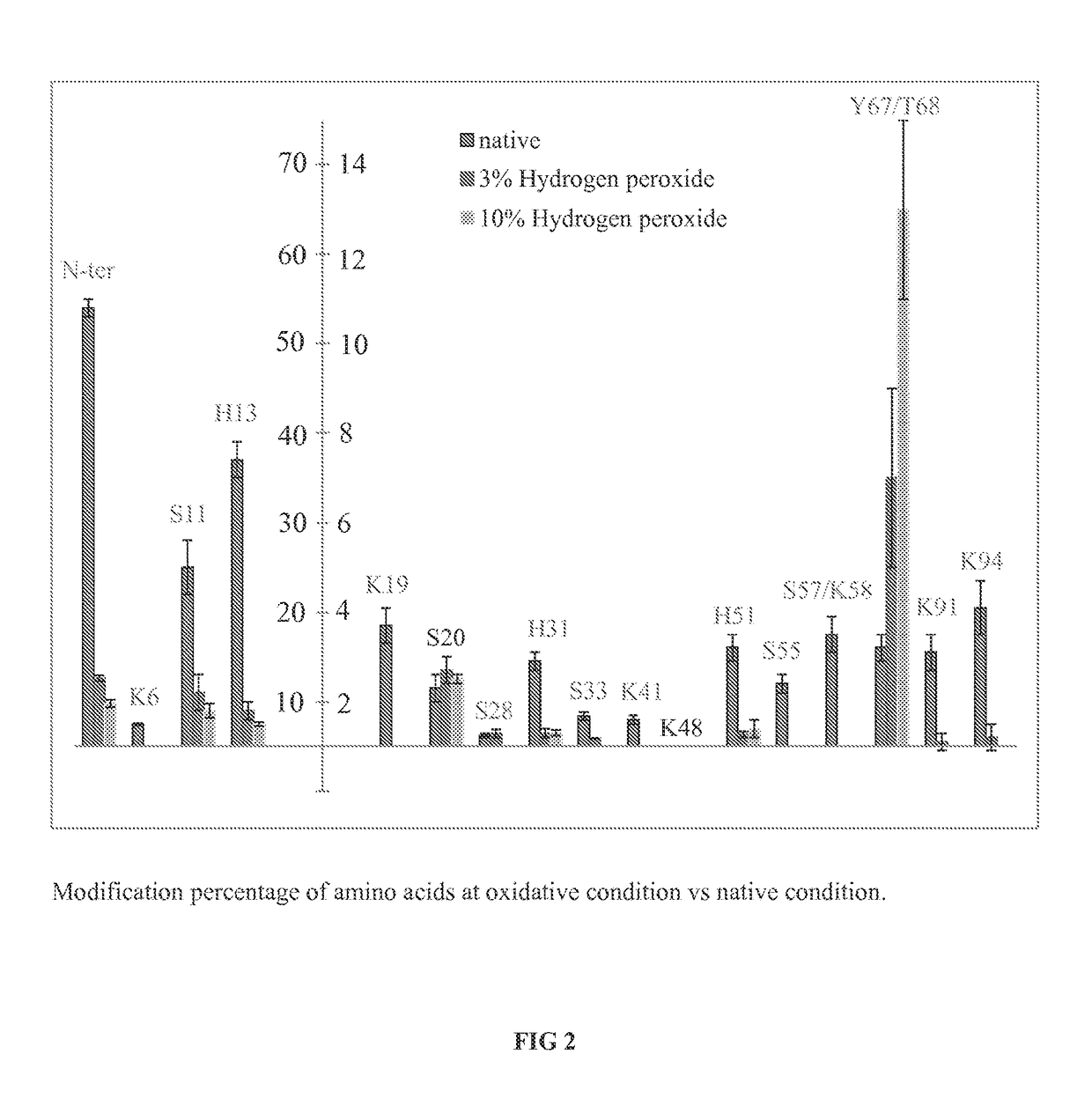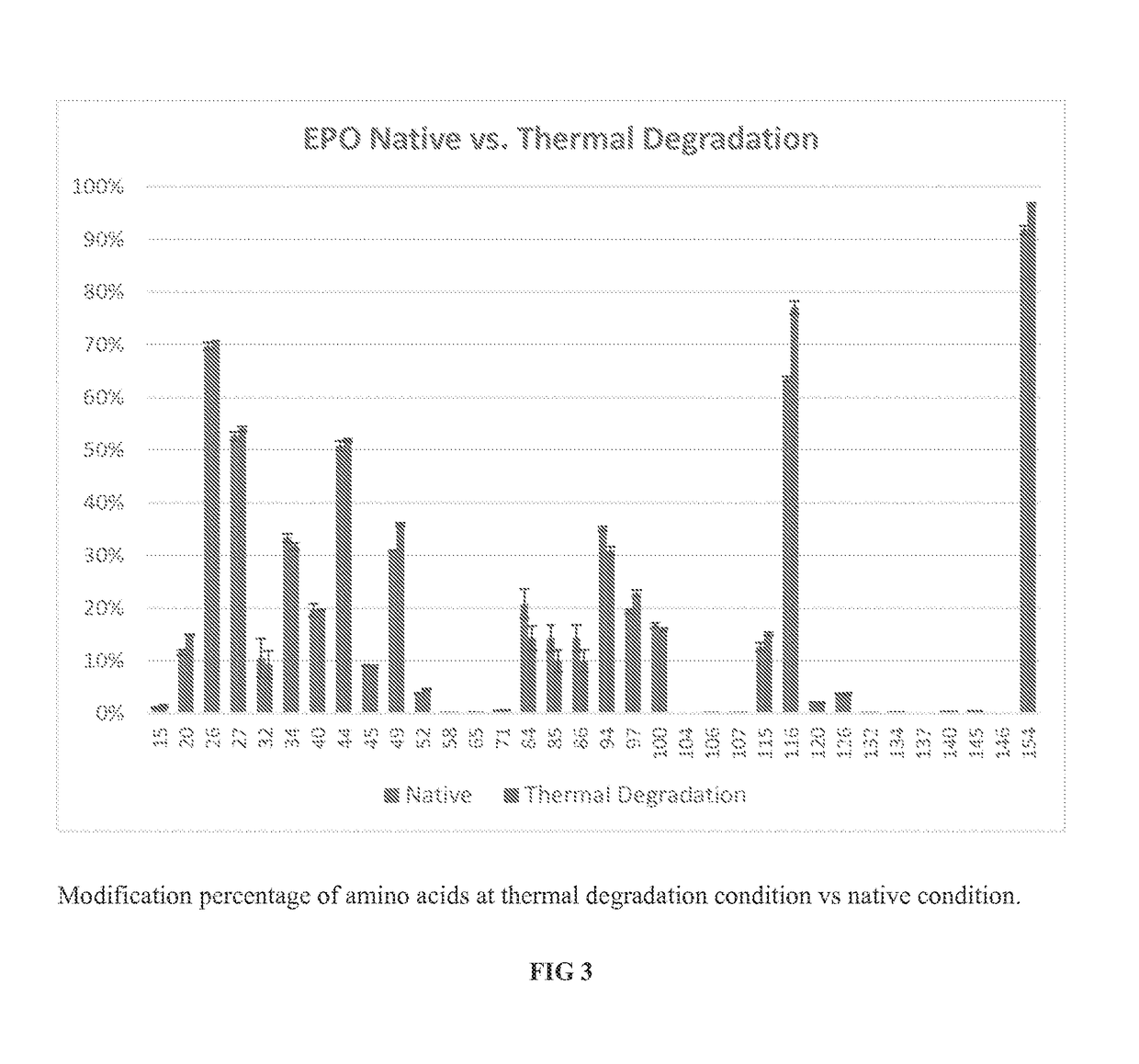Method for the comparison of protein higher order structures
a protein and higher-order technology, applied in the field of characterization of the higher-order structure of proteins, can solve the problems of increasing exponentially, inherent complexity of protein structures, and presenting challenges that must be addressed, and achieve the effect of accurate understanding
- Summary
- Abstract
- Description
- Claims
- Application Information
AI Technical Summary
Benefits of technology
Problems solved by technology
Method used
Image
Examples
example 2
ietin (EPO)
[0104]EPO was subject to thermal degradation at 50° C. for 2 hours, with samples processed in the same way as described for β-2-Microglobulin. Referring now to FIG. 3, % labeling for labeled residues is shown for two conditions, with the native conditions shown in the left-most bar for each residue, and thermal degradation conditions in the right-most bar. FIG. 3 shows that thermal degradation condition induced changes to the modification percentage of certain amino acids when compared to the native condition. For example, thermal degradation treatment increased the modification percentage of the residue (116) from about 62% to about 75% modification in EPO.
example 3
[0105]Heat Denaturation: IgG1 was analyzed either natively or after being incubated at 75° C. for 15 min.
[0106]DEPC Labeling: Labeling for IgG1 was performed using a 0.75 mM solution of DEPC in acetonitrile. The protein solutions had 5 μM IgG1 in 50 mM Phosphate buffer (pH 7.4). These solutions were reacted with DEPC at a 1:4 (protein:DEPC) ratio for 5 min (IgG1) at 22° C. The DEPC reaction was quenched by the addition of imidazole at a 1:50 (DEPC:Imidazole) ratio.
[0107]Proteolytic Digestion: The digestion was then performed using a 1:100 (papain:protein) ratio for 2.5 hours. Once complete, IgG1 was incubated in a buffered solution (50 mM phosphate buffer at pH 7.4) with 1 M urea, 20 mM DTT, and at 60° C. for 20 min. Next IgG1 was reacted for 2 min with 40 mM iodoacetamide to alkylate the resulting free thiols. Immobilized trypsin was then added to achieve a 1:3 (enzyme:substrate) ratio. The digestion reaction was allowed to proceed overnight at 22° C. After completion the samples w...
example 4
globulin Aggregation
[0109]β-2-Microglobulin samples from the previous example were analyzed for DEPC labeling patterns that correlate with protein aggregation. Additional β-2-Microglobulin degradation samples were generated by repeating the thermal degradation study previously described, but adding a reducing agent (TCEP) prior to labeling to further degrade the protein structure. All subsequent steps were identical to the method described previously for β-2-Microglobulin. Referring now to FIG. 7, % labeling is shown for residues 11, 13, 67, and 68 in the order of increasingly harsh conditions, in which the native conditions are shown via the left-most bar, heating for 30 min via the second bar from the left, heating / reducing 30 min via the third bar from the left, heating for 1 day via the fourth bar from the left, exposure to 3% HOOH via the fifth bar from the left, exposure to 10% HOOH via the sixth bar from the left, and heating / reducing for 1 day via the seventh bar from the le...
PUM
| Property | Measurement | Unit |
|---|---|---|
| molecular weight | aaaaa | aaaaa |
| molecular weight | aaaaa | aaaaa |
| volume | aaaaa | aaaaa |
Abstract
Description
Claims
Application Information
 Login to View More
Login to View More - R&D
- Intellectual Property
- Life Sciences
- Materials
- Tech Scout
- Unparalleled Data Quality
- Higher Quality Content
- 60% Fewer Hallucinations
Browse by: Latest US Patents, China's latest patents, Technical Efficacy Thesaurus, Application Domain, Technology Topic, Popular Technical Reports.
© 2025 PatSnap. All rights reserved.Legal|Privacy policy|Modern Slavery Act Transparency Statement|Sitemap|About US| Contact US: help@patsnap.com



